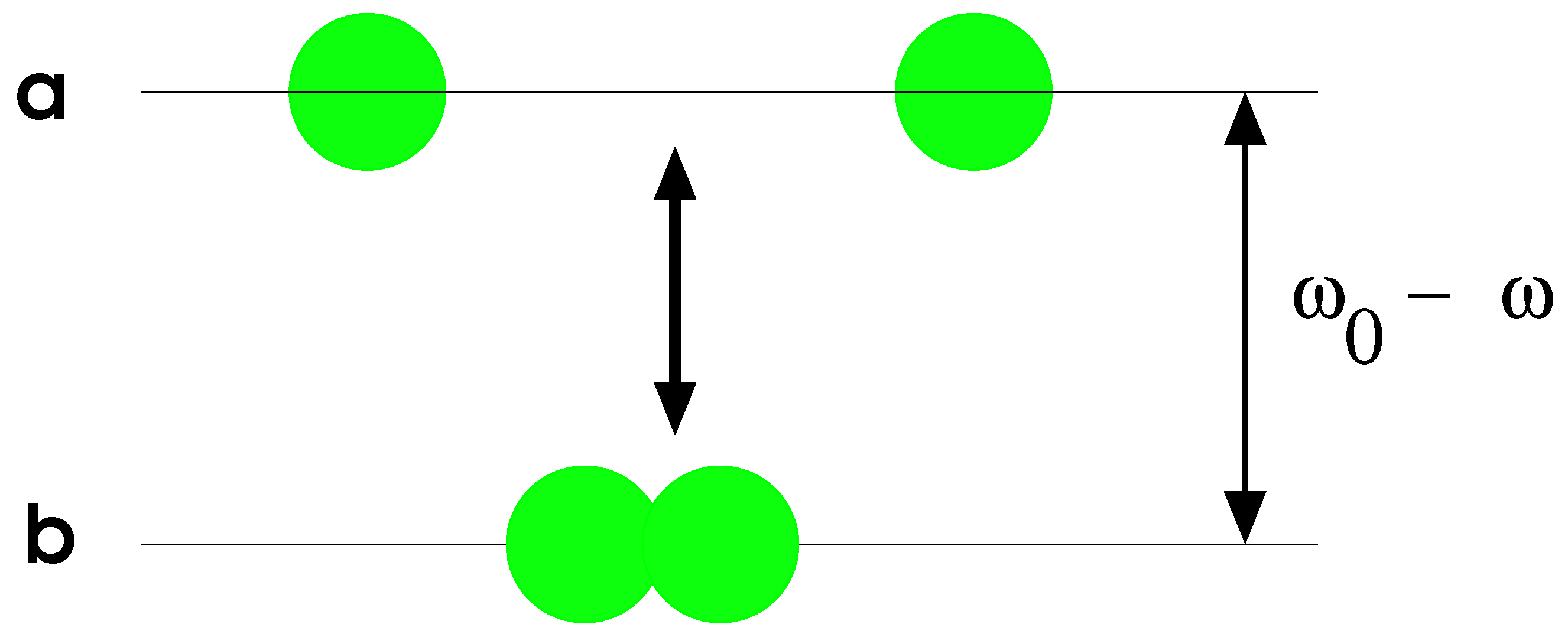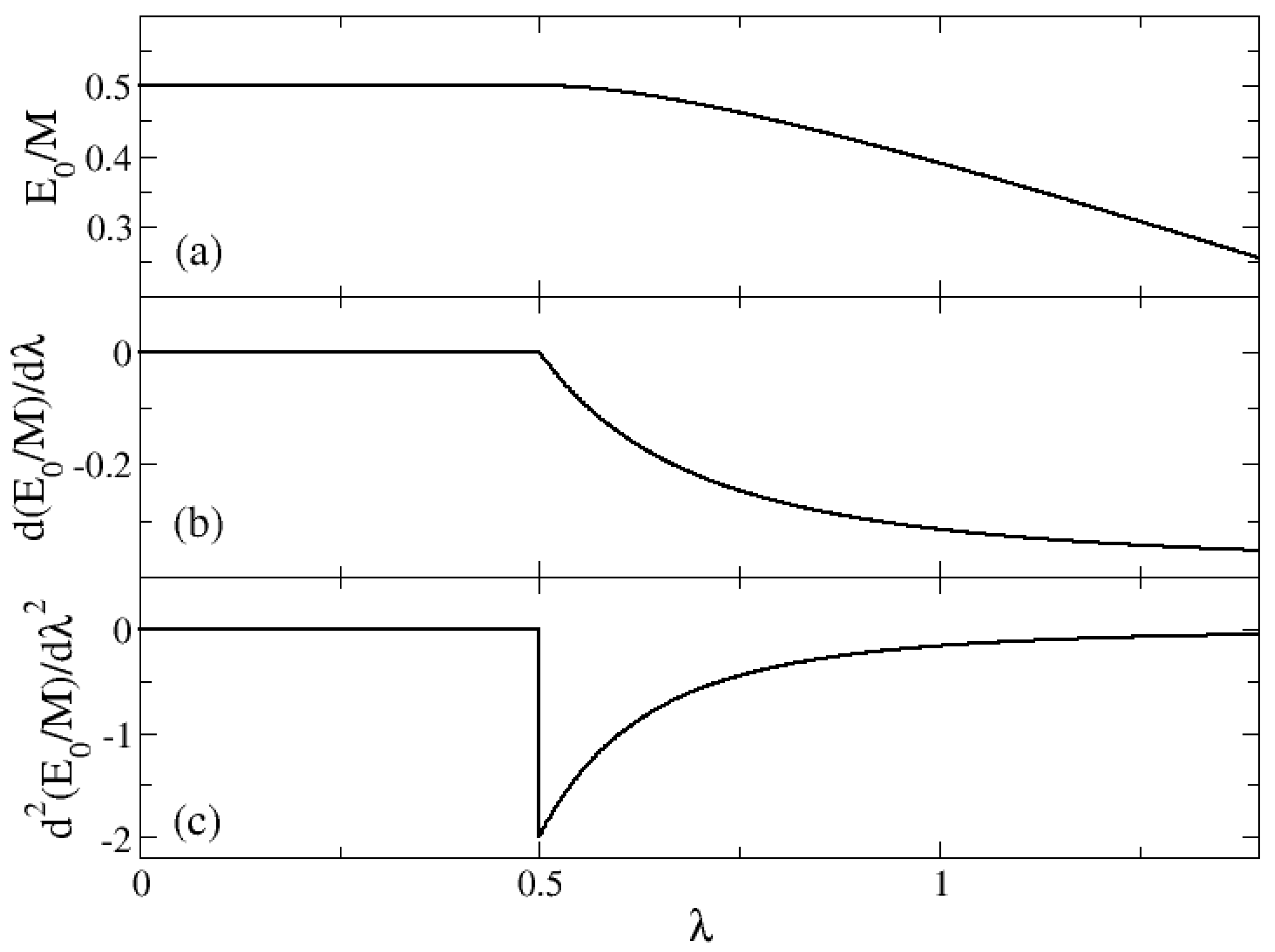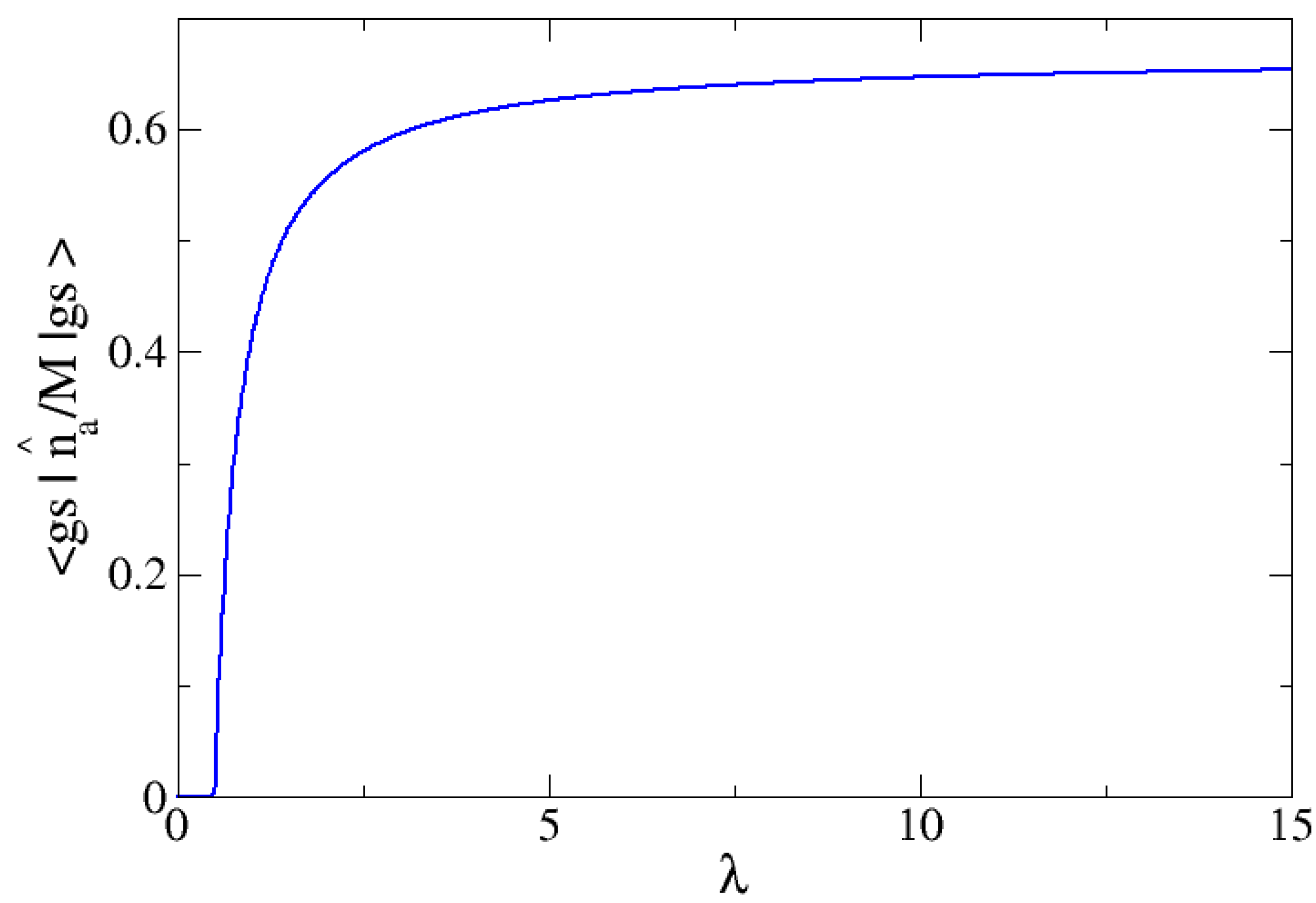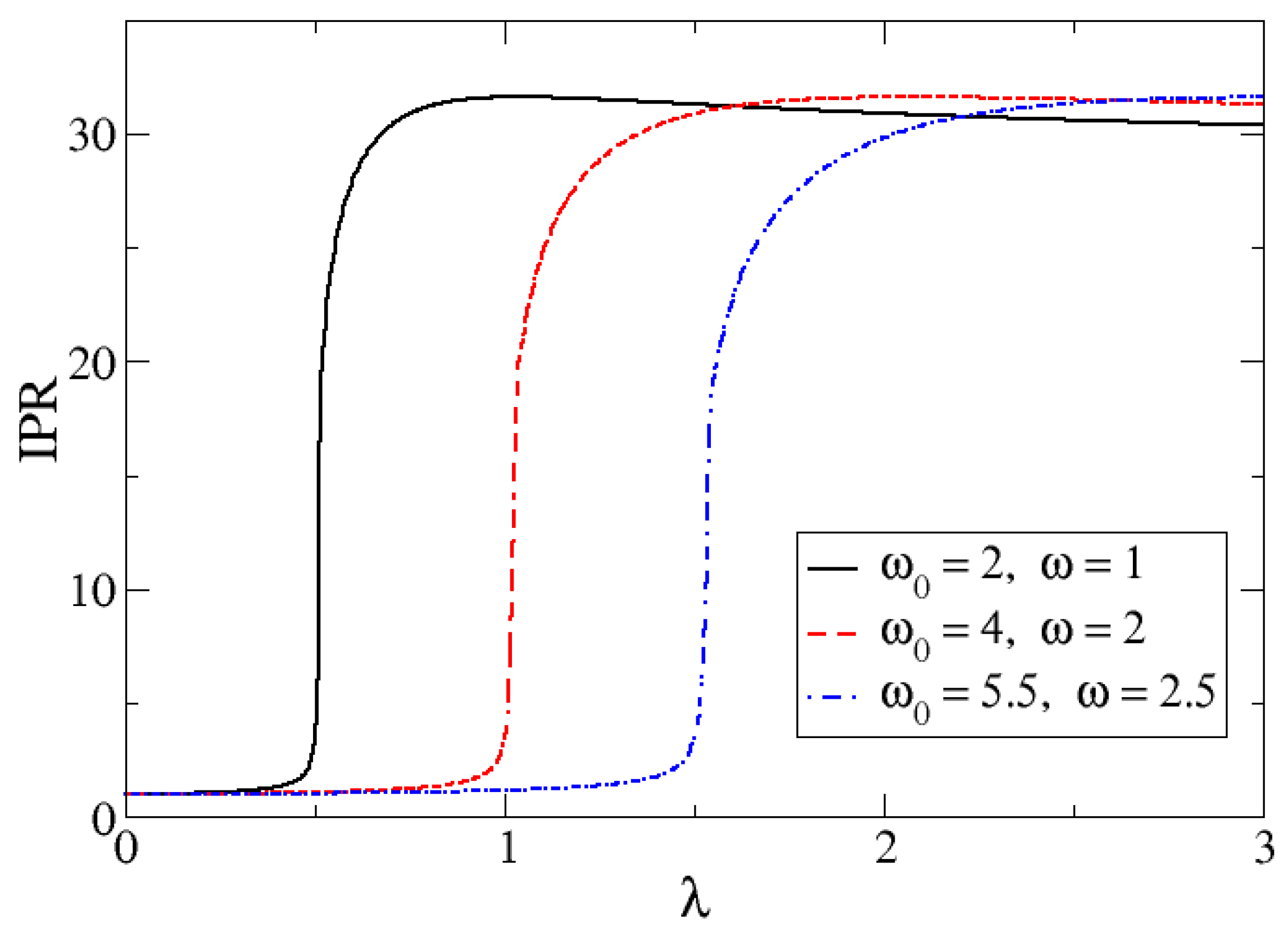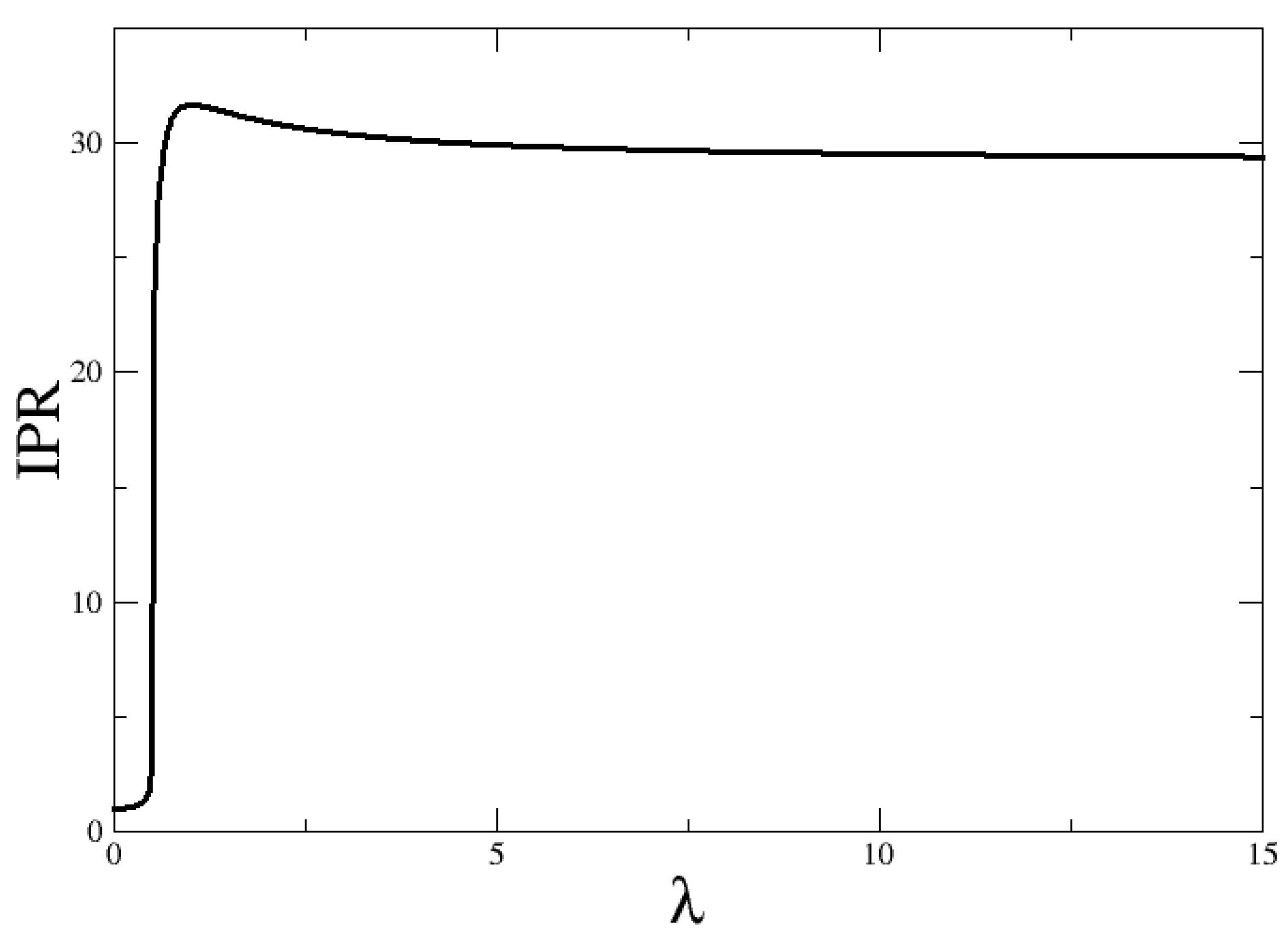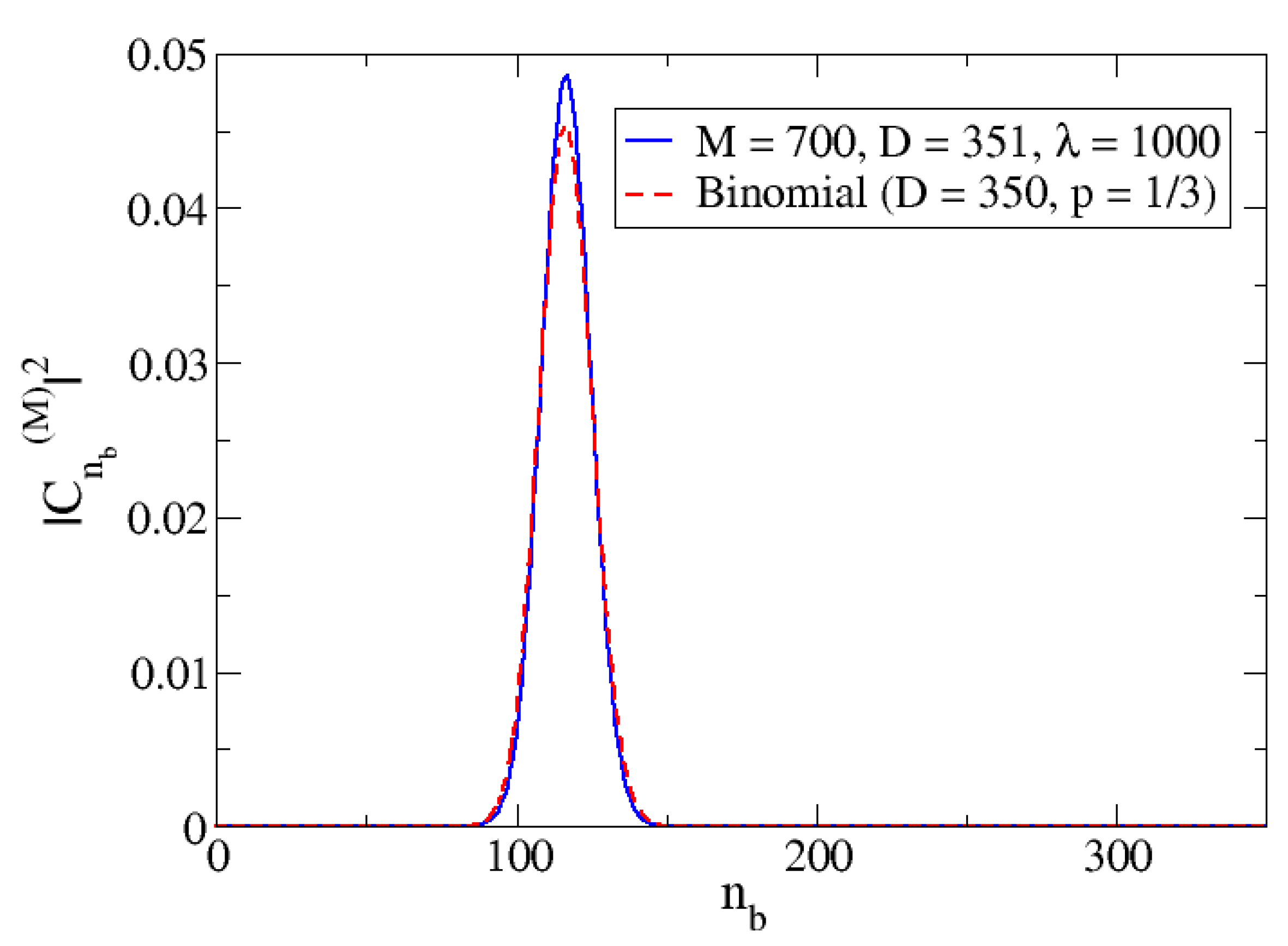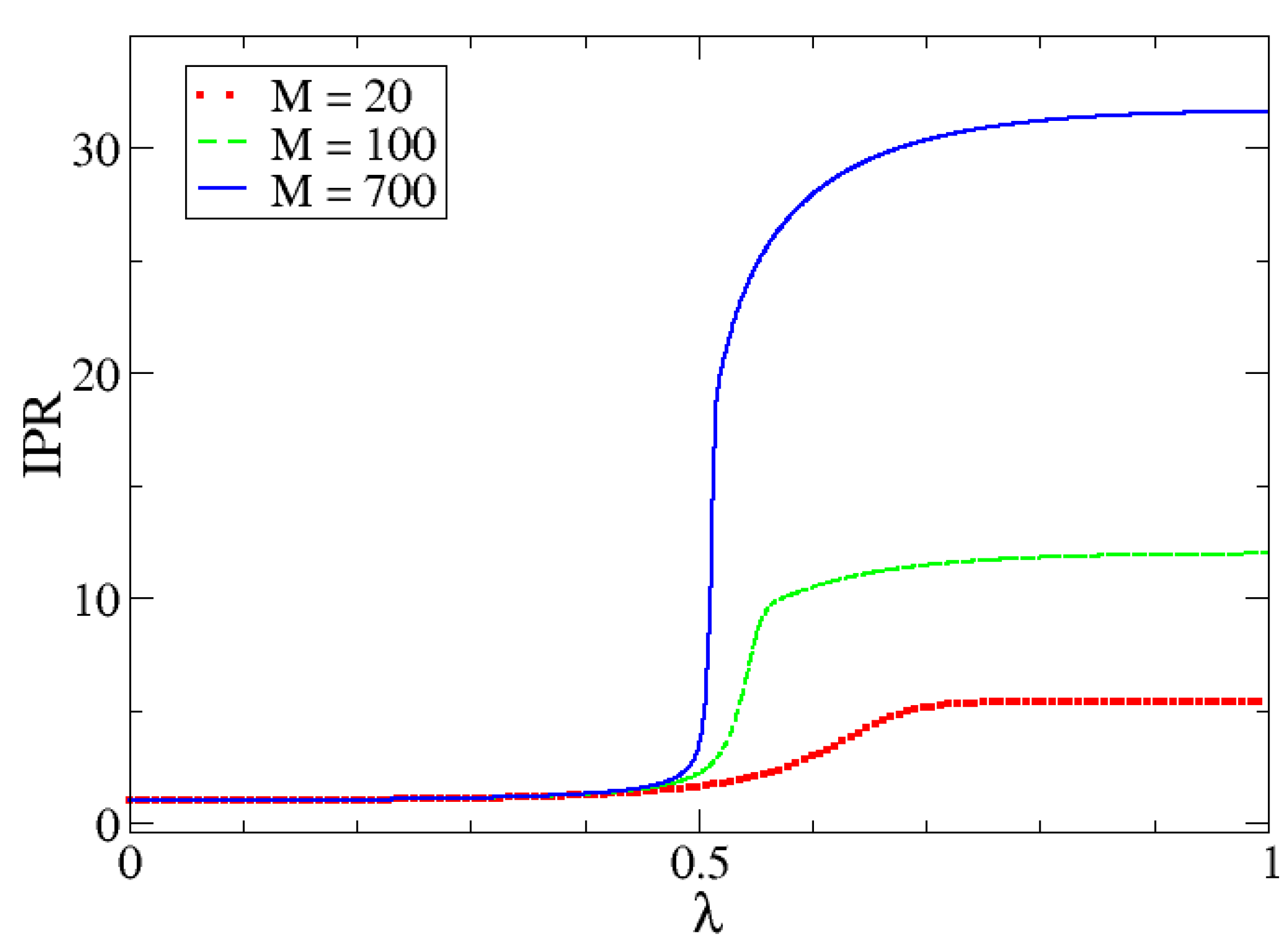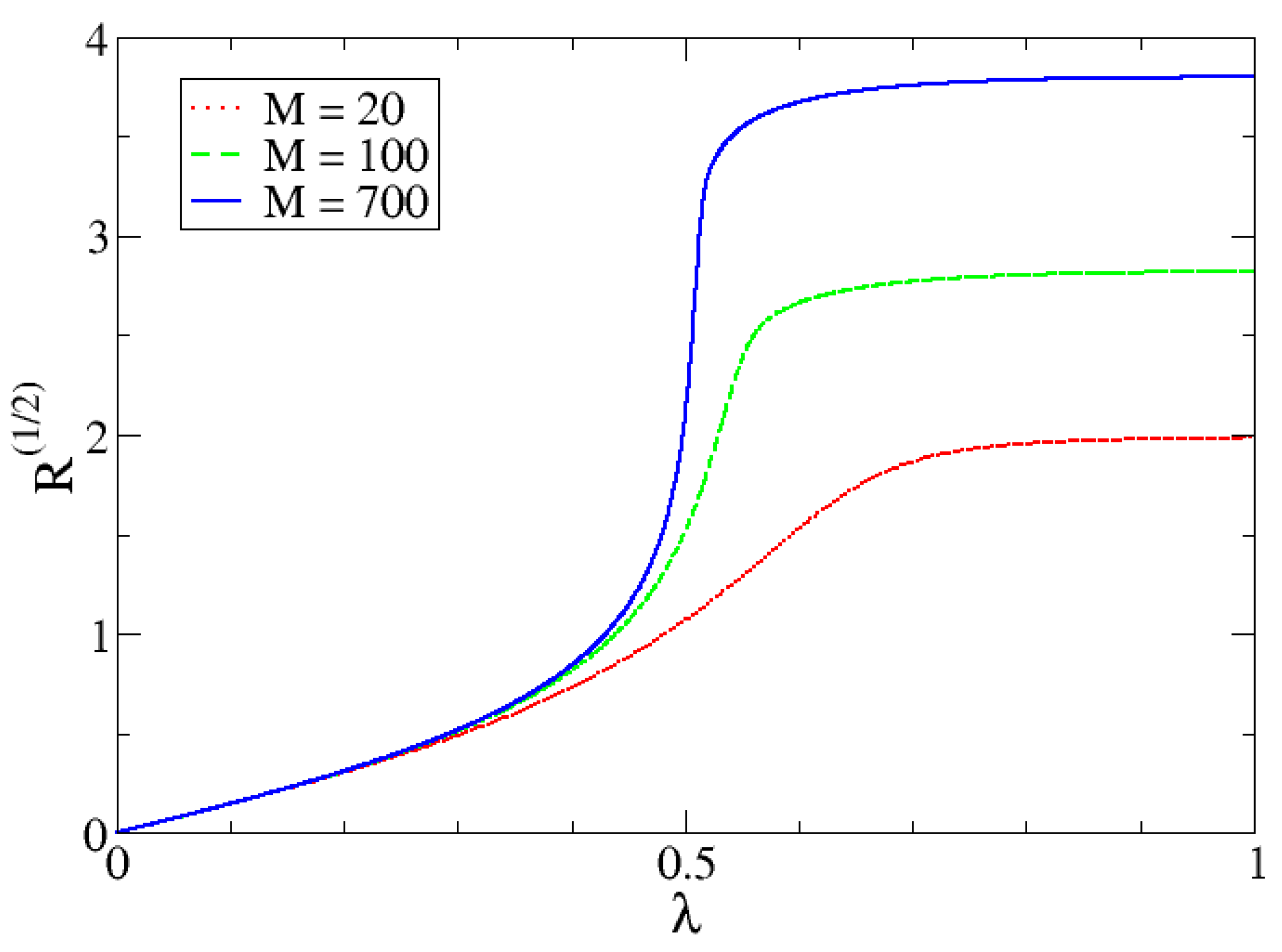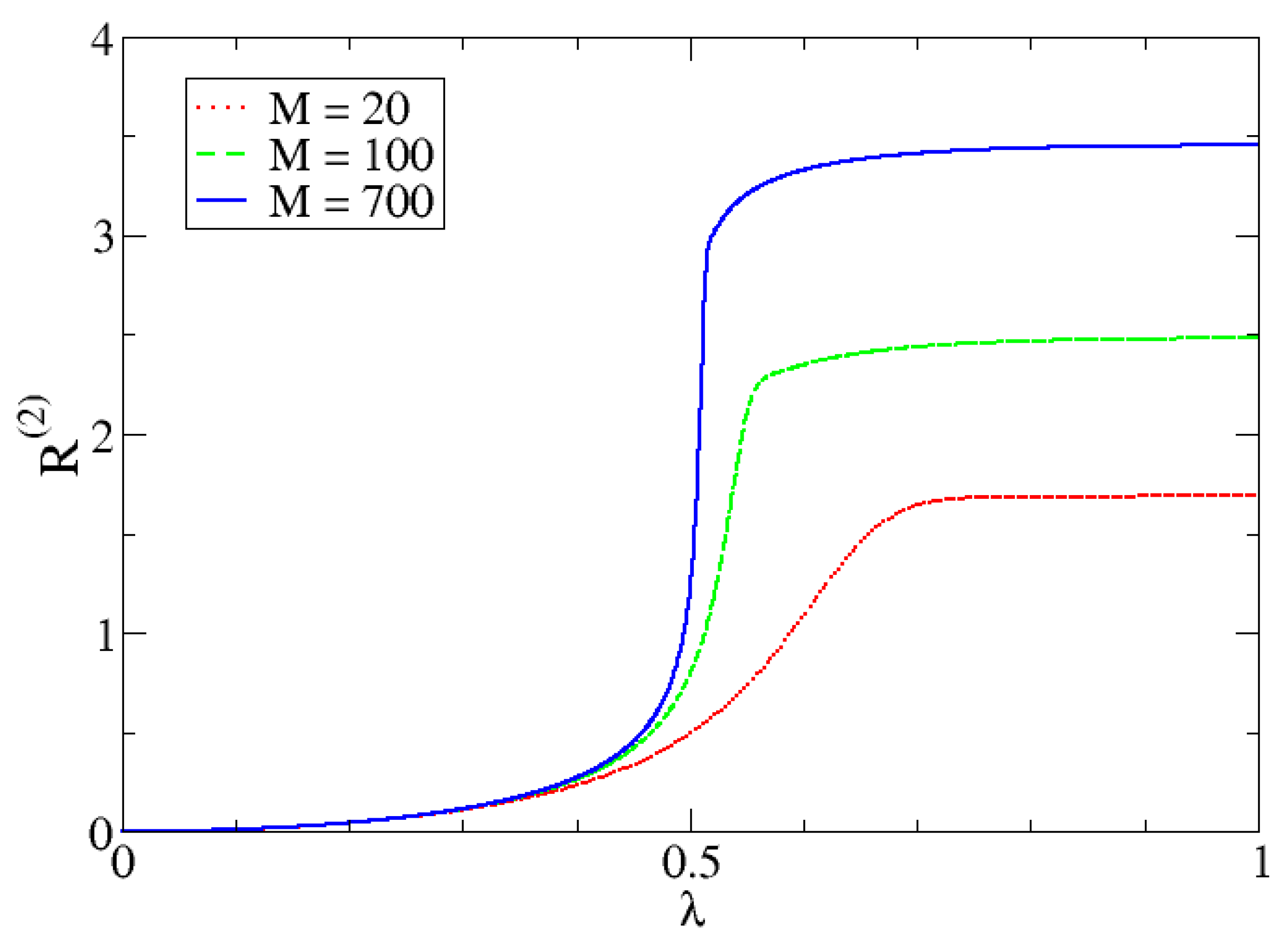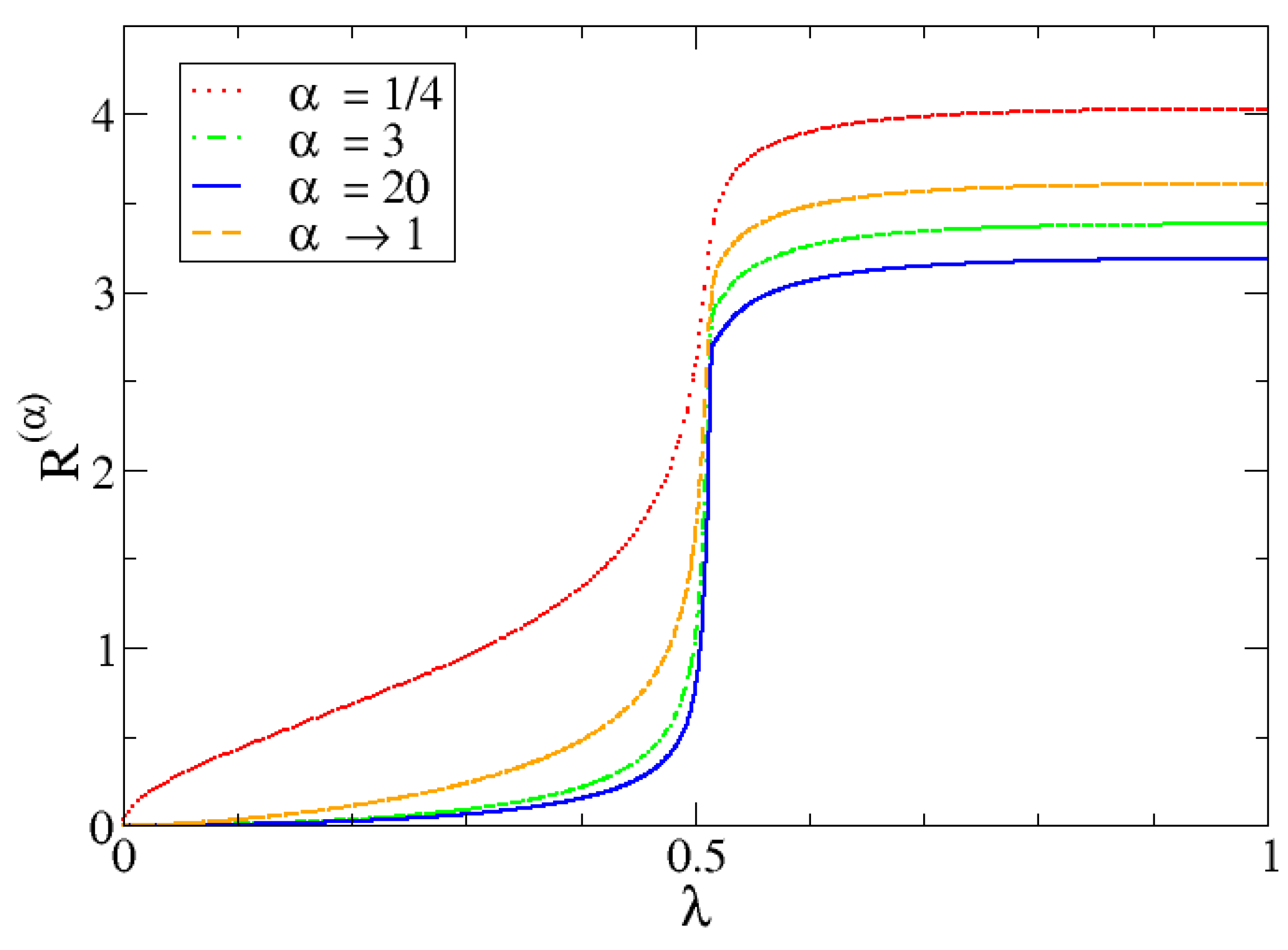In this section, we propose other markers for the critical point in the QPT.
3.1. Inverse Participation Ratio
The inverse participation ratio (IPR) is defined as
This magnitude measures the degree of delocalization of a quantum state within a specific basis. The coefficients
are the coefficients of the state
k in the used basis. On one hand, in case of full localization, the
k state is one of the basis states, so only one
and the IPR will be close to 1. On the other hand, if the state
k is equally distributed among all basis states, then the normalization condition is
with
D being the dimension of the matrix diagonalized. Then
In this case, the maximum IPR is obtained
. Consequently, any values of IPR between 1 and
are expected in general.
For the model discussed here, an IPR is expected for , since in this case our Hamiltonian eigenstates are those of the harmonic oscillator. For other –values, the Hamiltonian eigenstates will be a mixture of harmonic oscillator states and the IPR will increase. However, not every state of the harmonic oscillator will "participate" in the eigenstate of the coexistence phase. Only a linear combination of states in which the expected number of atoms is 2/3 of M will contribute. Thus, IPR will reach a constant but smaller size than the maximum possible value.
The numerical results from the exact diagonalization of the system Hamiltonian have already been presented, and these were compared to the mean-field results in the preceding section. For a given
M, the exact diagonalization produces the ground state, and consequently provides the coefficients
. With these, one can calculate the IPR (
32). In
Figure 6, the ground state IPR values for
and for different
choices as a function of the control parameter
are presented.
The IPR marks clearly the transition of the system at the corresponding . The ground state is well localized (small IPR) in the harmonic oscillator basis for below to the QPT critical point, whereas it tends to be delocalized for values of above the critical value. Indeed, an abrupt change of IPR occurs at in the QPT.
A natural question in relation to
Figure 6 is: what are the asymptotic values for
and
? In order to show the
, we plot in
Figure 7 the IPR for the cases
and
. It is seen that the IPR for large
is around 30.
Whilst an IPR = 1, or approximately 1, is expected for , for which the ground state is close to a molecular condensate (the state is basically ). For larger –values the Hamiltonian eigenstates will be mixtures of harmonic oscillator states, in which there will be more than one relevant state, and therefore, the IPR will increase. The limit of M/2+1 is obtained when all the basis states are contributing with equal weight. However, this is not reasonable, and states in which the number of atoms is , and consequently (we notice that ), are expected to have larger weights. In fact, if one assumes for the wavefunction coefficients a binomial distribution with D = M/2 components, , whose probability of is , the corresponding IPR would be around 31. Although the distribution in our ground state is not exactly binomial, something similar is expected. In that case, the IPR will not reach the maximum possible value, and an IPR around 31 is expected for M = 700.
In
Figure 8, the binomial distribution for D = 350 that corresponds to
M = 700 (basis dimension 351) and
p = 1/3 (which corresponds to
) is represented against
(dashed red line). Superimposed is the plot for the calculated ground state wavefunction components squared for the case
M = 700 and
(full blue line). The similarity of the distributions is clearly shown, and that is why the IPR value for the large
limit is close to the corresponding binomial distribution (around 30 in the case of
Figure 7).
In order to show the behavior of the IPR as a function of the system size, we present in
Figure 9 the IPR for different M-values. From this figure, we can observe that the bigger the size of the system, the sharper the change in the value of the IPR at the critical point.
A final comment on the IPR maximum observed right after the critical point: This is seen in
Figure 7. This exact same behavior is confirmed to exist for all sizes. It is not more or less accentuated depending on M. We have already established which states are relevant in both the molecular condensate phase and the coexistence phase. However, right after the critical value is reached, the state of minimum energy is given by a linear combination of a set of states wider than the one observed for large
values. It is a sort of transition region in which more components (fluctuations) are participating in the ground state wavefunction. As a consequence, the greatest value of the IPR is observed right there.
3.2. Renyi Entropy
Information was first defined rigorously by Claude Shannon [
21]. It is a magnitude that measures how much communication it takes to transmit a message. If one has a discrete list of possible messages (events) with different probabilities, that wishes to transmit, the information value of every message depends on that probability. For instance, if one were to repeat the same message over and over, the information transmitted is measured with lower units of information. Conversely, if within this list of repeated messages something different is suddenly communicated only once, it is considered to give much more information. In other words, information measures how surprising, how unlikely, an event is. Thus, information theory does not account for content or usefulness, rather it measures only the quantity of information. The later is measured by a magnitude called entropy.
Different entropies can be defined. The most popular entropy was defined by Shannon [
21],
where
Q are the generalized coordinates (
x and
y for our model), and
is the probability density (
, in our case). Then,
Here we propose to use the Rényi entropy [
22,
23] that depends on one parameter
, for characterising the phase transition in our system. The Rényi entropy has as a limit situation the Shannon entropy (
). The Rényi entropy is defined as
that for the model discussed is,
For the model under study, the ground state is a combination of harmonic oscillator states in the coordinates
,
where
are normalization constants and
are Hermite polynomials. The ground state coefficients
are obtained from the Hamiltonian diagonalization. Consequently, the entropies can be calculated with Equation (
39). However, this is computationally inefficient since for large M values it implies factorials of large numbers and make the calculation very heavy and inaccurate. As of that, we prefer to go to Shannon’s original idea. The entropy [
21] of a state describing a physical system is a quantity expressing the diversity, uncertainty or randomness of the system. Shannon viewed this uncertainty attached to the system as the amount of information carried by its state. His idea was based on the following consideration. If a physical system has a large uncertainty and one receives information on the system, then so-obtained information is more valuable (because it is less likely) than received from a system having less uncertainty. This is why entropy is measured in units of information. Shannon also drafted in
A mathematical theory of communication [
21] what is one of the most popular definitions of entropy. Let
be a discrete random variable with probability distribution
of
N elements. That is
then Shannon entropy is given by
When one takes the binary logarithm, entropy is expressed in shannons (Sh), also known as bits. Moreover, when taking the natural logarithm, as we do in this work, entropy is expressed in the natural unit of information or nat. It is merely a difference in scale (1 Sh nat). Note that if one event is much more likely than the others, that is and , then entropy tends to 0. In the opposite case, if all events were equally likely, then and , which is a function that increases with N. Furthermore, take notice of the fact that both the maximum and minimum possible values of Shannon entropy correspond to maximum and minimum values of IPR.
Should one need to measure the information provided by events giving it greater or lesser differences between likely and unlikely ones, a different definition of entropy would have to be used.
A generalization of Shannon entropy was made by Alfred Rényi [
22]. Classical Rényi entropy for a parameter
and
is defined for the same discrete random variable as
The same minimum and maximum possible values of entropy Rényi are reached, independently of . In fact, the limiting value of Rényi entropy as , that can be calculated using L’Hôpital’s rule, is the Shannon entropy .
In the context of quantum theory of information, for a density matrix in a Hilbert space,
, we can define quantum Rényi entropy [
24] as
If
are the diagonal elements of
in the basis of eigenfunctions, then the quantum Rényi entropy reduces to a Rényi entropy of a random variable
as defined in (
41). This means that for the ground state of our system we can define the probabilities
where
are the coefficients of the ground state wavefunction. Note that we already took the dimension of the Hamiltonian matrix
N as the number of elements in the discrete random distribution.
For , all random events are weighted more equally, resulting in a smaller change in entropy from one state to another. As tends to zero, the entropy is just the logarithm of the size of the support of , no matter the phase.
For , all random events are weighted more differently. As grows, more likely events make larger contributions to entropy, whereas less likely events are disregarded. This tends to give bigger differences between quantum phases.
For , we have Shannon entropy, which results in something in the middle of both cases.
Besides dependency, there is another factor which affects entropy values. As happens with thermodynamic entropy, quantum entropy is an extensive property, meaning that it scales with the size of the system. This behavior has already been hinted at by substituting into Shannon entropy a set of values equally likely.
On account of the above, results are expressed according to the following criteria.
All calculations have been done for , which gives .
In
Figure 10,
Figure 11 and
Figure 12 we can observe the dependency of different entropies with
M. The transition is sharper with increasing
M for all values of
. Note that entropy is independent of
M in one phase but is increasingly different with larger
M-values in the other phase. The reason behind this phenomenon lies in the characteristics of both phases.
In the first one, the possibility of measuring the lowest eigenvalue of the harmonic oscillator (), is almost 1 and the rest are almost zero (which is why the IPR is approximately 1). Since the dimension N is irrelevant (to a certain point), because it would not really matter how many there are, entropy values will be very similar and will mostly depend on . In the second phase, we need to reach a certain proportion of particles, given by a number of relevant coefficients that is proportional to M. This is the reason why the IPR also increases with M.
In
Figure 13, for a system of
, the values of
are represented for a set of
values both under and over the unit as well as the Shannon entropy, which is given by the limit
. It is confirmed that bigger values of
make the difference between both phases more evident since it distinguishes more abruptly between likely and unlikely events. It can be also confirmed that Shannon entropy is indeed between the entropy for
and
.
Perhaps plenty more examples and evaluations could be made by toying with different values of M and . However, the most important conclusion one should make is the following. The entropy, when set to an adequate for it to be a good marker, is yet another quantum magnitude that experiences an abrupt (but continuous, as seen for lower values) change from one phase to another, evidencing the existence of a second-order QPT.
